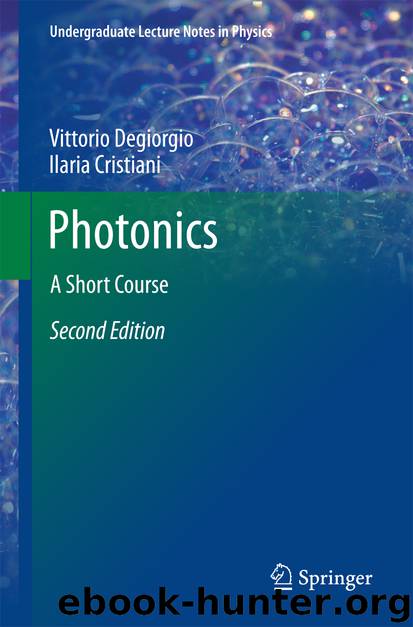Photonics by Vittorio Degiorgio & Ilaria Cristiani

Author:Vittorio Degiorgio & Ilaria Cristiani
Language: eng
Format: epub
Publisher: Springer International Publishing, Cham
Fig. 4.9Optical switch based on a twisted nematic liquid crystal cell. The switch is open if there is no applied voltage. The light beam is blocked if the liquid crystal molecules are forced to align parallel to z by a sufficiently large voltage
Liquid crystals are optically anisotropic: the nematic phase is birefringent and the cholesteric phase presents rotatory power. A light beam traveling across a nematic liquid crystal layer in a direction perpendicular to the molecular orientation behaves as an extraordinary wave if linearly polarized along the molecular axis. If an applied electric field forces the molecules to align parallel to the propagation direction of the light beam, then the wave becomes an ordinary wave. Therefore the effect of the electric field is that to change the phase delay experienced by the light beam, from to , where L is the layer thickness. Since the liquid crystal birefringence can be quite large, typically , a difference in phase delay equal to can be obtained with a layer thickness of just a few microns. It is therefore possible to make an electro-optic switch or modulator using a very thin liquid crystal film.
When a nematic liquid crystal material comes into contact with a solid surface, the molecules can become aligned either perpendicular to the surface (homeotropic ordering) or parallel to the surface (homogeneous ordering), depending on the treatment of the surface. In the case of homogeneous ordering, the orientation direction of the molecules is selected by rubbing the surface along a particular direction before it comes into contact with the liquid crystal. The molecules will take up an orientation parallel to the direction of rubbing.
A typical example of electro-optic effects in liquid crystals is given by the cell using a “twisted nematic liquid crystal”, as shown in Fig. 4.9. The liquid crystal layer is closed inside a glass cell, in which opposing walls are treated to produce a homogeneous ordering with orientations at right angles to each other. Thus the molecular axis undergoes a gradual rotation across the cell, from at one wall to at the opposite wall. The twisted nematic phase obtained in this way has the same rotatory power of a cholesteric phase. When a linearly polarized light beam travels across the cell its polarization direction undergoes a rotation. By applying a strong enough electric field perpendicularly to the cell walls, the molecules are forced to align homeotropically. In this state the light beam will travel across the cell without changing its polarization. By inserting the cell between two crossed polarizers, an electro-optic switch can then be constructed. With no applied voltage, the light beam is transmitted through the second polarizer. When voltage is applied the direction of polarization of the light traversing the cell is not rotated and hence cannot pass through the second polarizer. The device operates with an applied voltage of a few volts, but has long response times, since the electro-optic effect is based on molecular rotations. The typical application is in the field of displays, as it will be discussed in Chap.
Download
This site does not store any files on its server. We only index and link to content provided by other sites. Please contact the content providers to delete copyright contents if any and email us, we'll remove relevant links or contents immediately.
The Complete Stick Figure Physics Tutorials by Allen Sarah(7137)
Secrets of Antigravity Propulsion: Tesla, UFOs, and Classified Aerospace Technology by Ph.D. Paul A. Laviolette(4990)
Thing Explainer by Randall Munroe(3782)
The River of Consciousness by Oliver Sacks(3417)
The Order of Time by Carlo Rovelli(3073)
How To by Randall Munroe(2913)
I Live in the Future & Here's How It Works by Nick Bilton(2844)
A Brief History of Time by Stephen Hawking(2819)
What If?: Serious Scientific Answers to Absurd Hypothetical Questions by Randall Munroe(2543)
The Great Unknown by Marcus du Sautoy(2536)
Midnight in Chernobyl by Adam Higginbotham(2388)
Blockchain: Ultimate Step By Step Guide To Understanding Blockchain Technology, Bitcoin Creation, and the future of Money (Novice to Expert) by Keizer Söze(2379)
Networks: An Introduction by Newman Mark(2264)
The Meaning of it All by Richard Feynman(2213)
Easy Electronics by Charles Platt(2207)
The Tao of Physics by Fritjof Capra(2166)
Midnight in Chernobyl: The Untold Story of the World's Greatest Nuclear Disaster by Adam Higginbotham(2078)
When by Daniel H Pink(2021)
Introducing Relativity by Bruce Bassett(2018)
